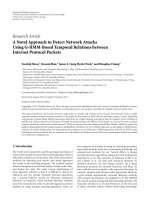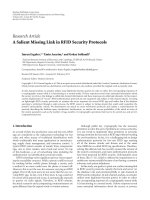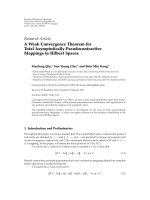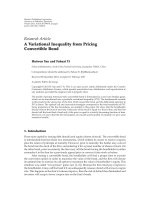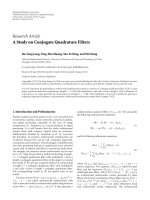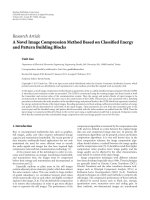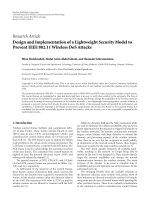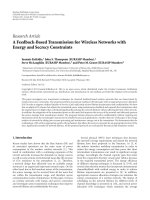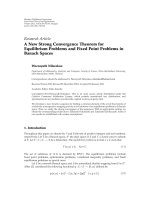báo cáo hóa học:" Research Article A Discrete Equivalent of the Logistic Equation" potx
Bạn đang xem bản rút gọn của tài liệu. Xem và tải ngay bản đầy đủ của tài liệu tại đây (684.26 KB, 15 trang )
Hindawi Publishing Corporation
Advances in Difference Equations
Volume 2010, Article ID 457073, 15 pages
doi:10.1155/2010/457073
Research Article
A Discrete Equivalent of the Logistic Equation
Eugenia N. Petropoulou
Division of Applied Mathematics and Mechanics, Department of Engineering Sciences, University of Patras,
26500 Patras, Greece
Correspondence should be addressed to Eugenia N. Petropoulou,
Received 29 September 2010; Accepted 10 November 2010
Academic Editor: Claudio Cuevas
Copyright q 2010 Eugenia N. Petropoulou. This is an open access article distributed under
the Creative Commons Attribution License, which permits unrestricted use, distribution, and
reproduction in any medium, provided the original work is properly cited.
A discrete equivalent and not analogue of the well-known logistic differential equation is
proposed. This discrete equivalent logistic equation is of the Volterra convolution type, is obtained
by use of a functional-analytic method, and is explicitly solved using the z-transform method.
The connection of the solution of the discrete equivalent logistic equation with the solution of the
logistic differential equation is discussed. Also, some differences of the discrete equivalent logistic
equation and the well-known discrete analogue of the logistic equation are mentioned. It is hoped
that this discrete equivalent of the logistic equation could be a better choice for the modelling
of various problems, where different versions of known discrete logistic equations are used until
nowadays.
1. Introduction
The well-known logistic differential equation was originally proposed by the Belgian
mathematician Pierre-Franc¸ois Verhulst 1804–1849 in 1838, in order to describe the growth
of a population Pt under the assumptions that the rate of growth of the population was
proportional to
A1 the existing population and
A2 the amount of available resources.
When this problem is “translated” into mathematics, results to the differential
equation
dP
t
dt
rP
t
1 −
P
t
K
,P
0
P
0
, 1.1
2AdvancesinDifference Equations
where t denotes time, P
0
is the initial population, and r, K are constants associated with the
growth rate and the carrying capacity of the population. A more general form of 1.1,which
will be used in this paper, is
y
t
βy
t
− γ
y
t
2
,y
0
a,
1.2
where t ∈
and a, β, γ are real constants with γ,β
/
0 in order to exclude trivial cases.
Equation 1.2 can be regarded as a Bernoulli differential equation or it can be solved
by applying the simplest method of separation of variables. In any case, the solution of the
initial value problem 1.2 is given by
y
t
aβ
aγ
β − aγ
e
−βt
.
1.3
Although, 1.2 can be considered as a simple differential equation, in the sense that it
is completely solvable by use of elementary techniques of the theory of differential equations,
it has tremendous and numerous applications in various fields. The first application of 1.2
was already mentioned, and it is connected with population problems, and more generally,
problems in ecology. Other applications of 1.2 appear in problems of chemistry, medicine
especially in modelling the growth of tumors, pharmacology especially in the production
of antibiotic medicines1, epidemiology 2, 3, atmospheric pollution, flow in a river 4,
and so forth.
Nowadays, the logistic differential equation can be found in many biology textbooks
and can be considered as a cornerstone of ecology. However, it has also received much
criticism by several ecologists. One may find the basis of these criticisms and several
paradoxes in 5.
However, as it often happens in applications, when modelling a realistic problem,
one may decide to describe the problem in terms of differential equations or in terms of
difference equations. Thus, the initial value problem 1.2 which describes the population
problem studied by Verhulst, could be formulated instead as an initial value problem of a
difference equation. Also, there is a great literature on topics regarding discrete analogues of
the differential calculus. In this context, the general difference equation
x
n1
λx
n
− μx
2
n
,x
1
a
or x
0
a
1.4
has been known as the discrete logistic equation and it serves as an analogue to the initial
value problem 1.2see, e.g., 6.
There are several ways to “end up” with 1.4 starting from 1.1 or 1.2 as:
a by iterating the function Fxμx1 − x, x ∈ 0, 1, μ>0 which gives rise to the
difference equation 7,page43
x
n1
μx
n
1 − x
n
, 1.5
Advances in Difference Equations 3
b by discretizing 1.1 using a forward difference scheme for the derivative, which
gives rise to the difference equation
x
n1
1 rh
x
n
−
rh
K
x
2
n
,x
0
a,
1.6
where x
n
P nh, h being the step size of the scheme 8,or
c by “translating” the population problem studied by Verhulst in terms of differences:
if p
n
is the population under study at time n ∈ , its growth is indicated by Δp
n
p
n1
− p
n
. Thus, according to the assumptions A1 and A2, the following initial
value problem appears:
Δp
n
rp
n
1 −
p
n
K
,p
0
P
0
⇒ p
n1
1 r
p
n
−
r
K
p
2
n
,p
0
P
0
. 1.7
Notice of course that all three equations 1.5–1.7 are special cases of 1.4.
The similarities between 1.2 and 1.4 are obvious even at a first glance. However,
these similarities are only superficial, since there are many qualitative differences between
their solutions. Perhaps the most important difference between 1.2 and 1.4 is that in
contrast to 1.2, the solution of which is given explicitly in 1.3 1.4or even its simplest
form 1.5 cannot be solved explicitly so as to obtain its solution in closed form except for
certain values of the parameterssee, e.g., 6, page 120 and 7,page14.
Also, 1.4 is one of the simplest examples of discrete autonomous equations leading
to chaos, whereas the solution 1.3 of 1.2 guarantees the regularity of 1.2. Finally, it
worths mentioning that the numerical scheme 1.6 or other nonlinear difference equations
approximations of
1.2 given for example in 6, page 120 or in 8, pages 297–303 gives rise
to approximate solutions of 1.2, which are qualitatively different from the true solution
1.3. These solutions are many times referred to as spurious solutions. These spurious
solutions “disappear” when better approximations are used, for example, by applying
nonstandard difference schemes see, e.g., 9–11.
Recently, in 12, 13 a nonstandard way was proposed for solving “numerically”
an ordinary differential equation accompanied with initial or boundary conditions in the
real or complex plane. This method was successfully applied to the Duffing equation, the
Lorenz system, and the Blasius equation. The technique used is based on the equivalent
transformation of the ordinary differential equation under consideration to an ordinary
difference equation through an operator equation utilizing a specific isomorphism in specific
Banach spaces. One of the aims of the present paper is to apply this technique to 1.2 so as
to obtain the following equation:
ny
n1
− β
1
y
n
−γ
1
n
k1
y
k
y
n−k1
,y
1
a,
1.8
where β
1
, γ
1
are constants, which in the rest of the paper will be called discrete equivalent logistic
equation. It should be mentioned at this point that although the application of the technique
in 12 to 1.2 is interesting on each own, its side effect, that is, the derivation of 1.8 is more
important, since it is proposed as the discrete equivalent of 1.2. It is also emphasized that
4AdvancesinDifference Equations
1.8 is the discrete equivalent logistic equation derived by straightforward analytical means
unlike the known versions of discrete logistic equation such as 1.4. Thus, the solutions of
1.8 are expected to have similar behavior with those of the differential logistic equation
and not the peculiar characteristics appearing in the solutions of 1.4 discussed above.
Conclusively it is the main aim of the present paper to convince the reader, that 1.8 deserves
to be called discrete equivalent logistic equation. It is also hoped that 1.8 could be a better
choice for the modelling of various problems, where different versions of known discrete
logistic equations are used until nowadays.
Equation 1.8 is a nonlinear Volterra difference equation of convolution type. The
Volterra difference equations have been thoroughly studied, and there exists an enormous
literature for them. For example, there are several results concerning the boundedness,
asymptotic behavior, admissibility, and periodicity of the solution of a Volterra difference
equation. Although the list of papers cited in the present work is by no means exhaustive, the
review papers 14, 15 on the boundedness, stability, and asymptoticity of Volterra difference
equations should be mentioned see also the references in these two papers. Indicatively,
one could also mention the papers 16–32, the general results of which can also be applied
to convolution-type Volterra difference equations. Also, in 33–36, linear Volterra difference
equations of convolution type are exclusively studied.
In Section 2, 1.8 is fully derived. Moreover, in the same section conditions are given
for the existence of a unique solution of 1.2 in the Banach space
H
1
Δ
f : Δ −→
where f
x
∞
n1
f
n
x
n−1
analytic in Δ with
∞
n1
f
n
< ∞
, 1.9
where Δ{x ∈
: |x| < 1} −1, 1 and of 1.8 in the Banach space
1
f
n
: −→ with
∞
n1
f
n
< ∞
. 1.10
It should be mentioned at this point that the issue of the existence of a unique solution in
1
of the discrete analogue logistic equation 1.4 has been studied in 37 under the framework
of a more general difference equation.
In Section 3, 1.8 is explicitly solved by applying the z-transform method. Finally, in
Section 4, several differences between 1.4 and 1.8 are discussed. These differences concern
their solutions see Figure 1, their bifurcation diagrams, and their stability.
2. Derivation of the Discrete Equivalent Logistic Equation
In this section, the method proposed in 12, 13 will be applied to 1.2. As already mentioned
in the introduction, the main idea is to transform 1.2 into an equivalent operator equation
in an abstract Banach space and from this to deduce the equivalent difference equation 1.8.
This method can be applied only when the ordinary differential equation under consideration
is studied in the Banach space H
1
Δ defined by 1.9. Moreover, the solution of 1.8,which
will eventually give the solution of 1.2, belongs to the Banach space of absolutely summable
sequences
1
defined by 1.10.
Advances in Difference Equations 5
2.1. Basic Definitions and Propositions
First of all, define the Hilbert space H
2
Δ by
H
2
Δ
f : Δ −→
where f
x
∞
n1
f
n
x
n−1
analytic in Δ with
∞
n1
f
n
2
< ∞
, 2.1
where Δ{x ∈
: |x| < 1} −1, 1. Denote now by H an abstract separable Hilbert space
over the real field, with the orthonormal base {e
n
}, n 1, 2, 3, Denote by ·, · and ·
the inner product and the norm in H, respectively. Define also in H the shift operator V and
its adjoint V
∗
Ve
n
e
n1
,n 1, 2, 3, ,
V
∗
e
n
e
n−1
,n 2, 3, , V
∗
e
1
0,
2.2
as well as the diagonal operator C
0
C
0
e
n
ne
n
,n 1, 2, 3, 2.3
Proposition 2.1. The representation
f
x
,f
∞
n1
f
n
x
n−1
f
x
,x∈ Δ,
2.4
is a one-by-one mapping from H onto H
2
Δ which preserves the norm, where f
x
∞
n1
x
n−1
e
n
,
f
0
e
1
, is the complete system in H of eigenvectors of V
∗
and f
∞
n1
f
n
e
n
∞
n1
f, e
n
e
n
an
element of H [38].
Theuniqueelementf
∞
n1
f
n
e
n
∞
n1
f, e
n
e
n
appearing in 2.4 is called the
abstract form of fx in H. In general, if Gfx is a function from H
2
Δ to H
2
Δ and Nf
is the unique element in H for which
G
f
x
f
x
,N
f
, 2.5
then Nf is called the abstract form of Gfx in H.
Consider now the linear manifold of all fx ∈ H
2
Δ which satisfy the condition
∞
n1
|f
n
| < ∞.Definethenormfx
H
1
Δ
∞
n1
|f
n
|. Then, this manifold becomes
the Banach space H
1
Δ defined by 1.9.DenotealsobyH
1
the corresponding by the
representation 2.4, abstract Banach space of the elements f
∞
n1
f
n
e
n
∞
n1
f, e
n
e
n
∈
H for which
∞
n1
|f
n
| < ∞.
6AdvancesinDifference Equations
The following properties hold 38–40:
1 H
1
is invariant under the operators V
k
, V
∗
k
, k 1, 2, 3, as well as under every
bounded diagonal operator;
2 the abstract form of f
x is the element C
0
V
∗
f,thatis,f
xf
x
,C
0
V
∗
f;
3 the abstract form of fx
2
is the element NffV f,thatis,
f
x
2
f
x
,N
f
, where f
V
∞
n1
f
n
V
n−1
, and
f
V
1
f
2
1
;
2.6
4 the operator Nf is the Frech
´
et differentiable in H
1
.
Proposition 2.2. The linear function
φ : H
1
−→
1
,
φ
f
f, e
n
f
n
2.7
is an isomorphism from H
1
onto
1
, that is, it is a 1 − 1 mapping from H
1
onto
1
which preserves the
norm [37].
Remark 2.3. The basic Propositions 2.1 and 2.2 were originally proved for complex valued
sequences and functions z also in
,aswellasforH, H
1
defined over the complex field.
However, in the present paper a restriction to the real plane is made due to the physical
applications of the logistic equation.
2.2. Derivation of 1.8
In order to apply the method of 12, 13 to the logistic differential equation 1.2,itis
considered that |t| <T, T>0finiteand1.2 is restricted to Δ−1, 1 by using the simple
transformation x t/T, ytyxTYx. Then, 1.2 becomes
Y
x
− βTY
x
−γT
Y
x
2
,Y
x 0
a, γ
/
0.
2.8
Using Proposition 2.1 and what mentioned in Section 2.1, 2.8 is rewritten as
f
x
,C
0
V
∗
Y
− βT
f
x
,Y
−γT
f
x
,N
Y
⇐⇒
f
x
,C
0
V
∗
Y − βTY γTN
Y
0,Y
∞
n1
Y
n
e
n
∞
n1
Y, e
n
e
n
,
2.9
which holds for all f
x
, x ∈ Δ.Butf
x
is the complete system in H of eigenvectors of V
∗
,which
gives the following equivalent operator equation:
C
0
V
∗
Y − βTY −γTN
Y
. 2.10
Advances in Difference Equations 7
By taking the inner product of both parts of 2.10 with e
n
and taking into consideration
Proposition 2.2 one obtains
C
0
V
∗
Y, e
n
− βT
Y, e
n
−γT
N
Y
,e
n
⇒
V
∗
Y, C
0
e
n
− βT
Y, e
n
−γT
∞
k1
Y
k
V
k−1
Y, e
n
⇒ n
V
∗
Y, e
n
− βT
Y, e
n
−γT
∞
k1
Y
k
V
k−1
Y, e
n
⇒ n
Y, V e
n
− βT
Y, e
n
−γT
∞
k1
Y
k
Y,
V
∗
k−1
e
n
⇒ n
Y, e
n1
− βT
Y, e
n
−γT
∞
k1
Y
k
Y, e
n−k1
⇒ nY
n1
− β
1
Y
n
−γ
1
n
k1
Y
k
Y
n−k1
,
2.11
where β
1
βT, γ
1
γT,whichis1.8, the discrete equivalent logistic equation. It is obvious that
in 2.11,itisn 1, 2, 3, and that Y
1
a,sinceYx 0
∞
n1
Y
n
x
n−1
|
x0
Y
1
a and
Y, e
1
Y
1
.
Of course, for all the above to hold, one has to assure that Yx ∈ H
1
Δ and Y
n
∈
1
.
This is guaranteed by the theorems presented in the next section.
2.3. Existence and Uniqueness Theorems
As mentioned in Section 2.2, conditions must be found so that Yx ∈ H
1
Δ and Y
n
∈
1
.In
order to do so, it is helpful to work with the operator equation 2.10, which is equivalent to
both 2.8 and 2.11.Equation2.10 can be rewritten as
V
∗
Y − βTB
0
Y −γTB
0
N
Y
, 2.12
where B
0
is the bounded operator B
0
e
n
1/ne
n
, n 1, 2, 3, or as
I − βTV B
0
Y −γTVB
0
N
Y
ce
1
, 2.13
due to the definition of V
∗
,wherec is a constant which can be defined by taking the inner
product of both parts of 2.13 with the element e
1
. Indeed, this gives
Y, e
1
− βT
VB
0
Y, e
1
−γT
VB
0
N
Y
,e
1
c
e
1
,e
1
⇒
∞
n1
Y
n
e
n
,e
1
− βT
B
0
Y, V
∗
e
1
−γT
B
0
N
Y
,V
∗
e
1
c
e
1
,e
1
⇒ Y
1
− βT
B
0
Y, 0
−γT
B
0
N
Y
, 0
c ⇒ c Y
1
a,
2.14
8AdvancesinDifference Equations
since Y z 0a.Thus2.13 becomes
I − βTV B
0
Y −γTVB
0
N
Y
ae
1
. 2.15
In order to assure the existence of a unique solution of the nonlinear operator equation
2.15 in H
1
, some conditions must be imposed on the parameters appearing in the equation.
Moreover, since it is a non linear equation, a fixed-point theorem would be useful. Indeed,
the following well-known theorems concerning the inversion of linear operators and the
existence of a unique fixed point of an equation will be used.
Theorem 2.4. If T is a linear bounded operator o f a Hilbert space H or a Banach space B,with
T < 1,thenI − T is invertible with I − T
−1
≤1/1 −T and is defined on all H or B (see,
e.g., [41, pages 70-71] ).
Theorem 2.5. If f : X → X is holomorphic, that is, its Fr
´
echet derivative exists, and fX lies
strictly inside X,thenf has a unique fixed point in X,whereX is a bounded, connected, and open
subset of a Banach space E. (By saying that a subset X
of X lies strictly inside X,itismeantthat
there exists an
1
> 0 such that x
− y >
1
for all x
∈ X
and y ∈ E − X)[42].
If it is assumed that
β
T<1, 2.16
then −βTV B
0
1
< 1andduetoTheorem 2.4, the operator I −βTVB
0
−1
is defined on all H
1
and is bounded by 1/1 −|β|T.Thus,2.15 takes the form
Y
I − βTV B
0
−1
−γTVB
0
N
Y
ae
1
g
Y
,
2.17
from which one finds that
g
Y
1
≤
1
1 −
β
T
γ
T
Y
2
1
|
a
|
.
2.18
Suppose that Y
1
≤ R. Then, from 2.18 it is obvious that
g
Y
1
≤
1
1 −
β
T
γ
TR
2
|
a
|
.
2.19
Define the function PRR − |γ|T/1 −|β|TR
2
, which attains its maximum P
0
1 −
|β|T/4|γ|T at the point R
0
1 −|β|T/2|γ|T. Then, for Y
1
≤ R
0
− <R
0
, >0, it follows
that if
|
a
|
1 −
β
T
≤ P
0
− <P
0
,
2.20
Advances in Difference Equations 9
or if
|
a
|
<
1 −
β
T
2
4
γ
T
,
2.21
then 2.19 gives gY
1
≤ P
0
− R
0
− P
0
R
0
− <R
0
, which means that Theorem 2.5 is
applied to 2.17. Thus, the following has just been proved.
Theorem 2.6. If conditions 2.16 and 2.21 hold, then the abstract operator equation 2.10 has a
unique solution in H
1
bounded by R
0
1 −|β|T/2|γ|T.
Equivalently, this theorem can be “translated” to the following two.
Theorem 2.7. If conditions 2.16 and 2.21 hold, then the discrete equivalent logistic equation
2.11, has a unique solution in
1
bounded by R
0
.
Theorem 2.8. If conditions 2.16 and 2.21 hold, then the logistic differential equation 1.2 has a
unique analytic solution of the form yt
∞
n1
Y
n
t
n−1
/T
n−1
bounded by R
0
, which together with
its first derivative converges absolutely for |t| <T.(Thecoefficients Y
n
are defined of course by 2.11).
Remark 2.9. Following the same technique as the one applied for the proof of Theorems 2.6
and 2.7, conditions were given in 37, so that the difference equation 1.4 is to have a unique
solution in
1
or
1
{λ − 1/μ}, μ
/
0. Indeed, it was proved that
a if |λ| < 1and|a| < 1 −|λ|/4|μ|,then1.4 has a unique solution in
1
and
b if |2 −λ| < 1and|a −λ −1/μ| < 1 −|2 −λ|/4|μ|, then 1.4 has a unique solution
in
1
{λ − 1/μ}, μ
/
0.
It is obvious that conditions 2.16 and 2.21 are very similar to the conditions derived
in 37.
3. Solution of the Discrete Equivalent Logistic Equation
In this section, the discrete equivalent logistic equation 2.11,thatis,equation
nY
n1
− β
1
Y
n
−γ
1
n
k1
Y
k
Y
n−k1
,n 1, 2, 3, , Y
1
a
3.1
will be solved by applying the well-known z-transform method see, e.g., 6, pages 77–82,
7,Chapter6,and8, pages 159–172. Suppose ZY
n
∞
j0
Y
j
z
−j
Y z is the z-transform
of the unknown sequence Y
n
. It is obvious that Y
0
is required. However, since n starts from
1, an “overstepping” should be made, by defining arbitrarily Y
0
in such a way so that 3.1 is
consistent. Indeed, by setting n 0to3.1,oneobtainsY
0
0.
Equation 3.1 is of convolution type, and it can be rewritten as
nY
n1
− β
1
Y
n
−γ
1
Y
n
∗ Y
n1
. 3.2
10 Advances in Difference Equations
Taking the z-transform of both sides of 3.2,oneobtains
Z
nY
n1
− β
1
Z
Y
n
−γ
1
Z
Y
n
∗ Y
n1
⇒−z
d
dz
Z
Y
n1
− β
1
Z
Y
n
−γ
1
Z
Y
n
Z
Y
n1
⇒−z
d
dz
z
Y
z
− zY
0
− β
1
Y
z
−γ
1
Y
z
z
Y
z
− zY
0
⇒
Y
z
z β
1
z
2
Y
z
γ
1
z
Y
z
2
,
3.3
which is a Bernoulli differential equation with respect to
Y z. Remember that the original
differential equation 1.2 was also of Bernoulli type!
The solution of 3.3 is
Y
z
1
γ/β
ce
−β
1
/z
z
,
3.4
where c is the arbitrary constant of integration. This constant c can be determined by using
the following property of this z-transform since Y
0
0:
lim
z →∞
z
Y
z
Y
1
,
3.5
from which it is easily obtained that c β − aγ/βa.Thus,3.4 becomes
Y
z
aβ
aγ
β − aγ
e
−βT/z
z
.
3.6
It should be mentioned at this point that since Y
n
∈
1
according to Theorem 2.7, the function
Y z defined by 3.6 is analytic for |z|≥1 see 7, Theorem 6.14, page 292.Byexpanding
Y z,itisfoundthat
Y
n
1
n!
d
n
f
dω
n
ω0
,f
ω
aβω
aγ
β − aγ
e
−βTω
,
3.7
which is the solution of 3.1.
Remark 3.1. The well-known properties of the z-transform
lim
z →∞
Y
z
Y
0
0
, lim
z →1
z − 1
Y
z
lim
n →∞
Y
n
0sinceY
n
∈
1
,
3.8
areofcoursesatisfied.
Advances in Difference Equations 11
Remark 3.2. The solution 3.7 of 3.1 is expected, since the analytic solution 1.3 of 1.2 is
known. However, the same technique can be applied to other nonlinear ordinary differential
equations of interest for which their analytic solutions are not available. In this sense, a
connection between specific ordinary differential and difference equations can be established.
4. Discussion
In this section, a comparison between the solutions of 1.4 and 1.8 will be given. However,
since the most commonly used form of the discrete logistic equation is 1.5
x
n1
μx
n
1 − x
n
, 4.1
a comparison between the preceding equation and 1.8 for β
1
γ
1
μ,thatis,
ny
n1
− μy
n
−μ
n
k1
y
k
y
n−k1
,
4.2
will be given.
First of all, something should be mentioned regarding the stability of the equilibrium
points of 4.1 and 4.2.AtRemark 2.9, it was mentioned that if
μ
< 1,
|
x
1
|
<
1 −
μ
4
μ
,μ
/
0, 4.3
equation 4.1 has a unique solution in
1
,whereasif
2 − μ
< 1,
x
1
−
μ − 1
μ
<
1 −
2 − μ
4
μ
,μ
/
0, 4.4
equation 4.1 has a unique solution in
1
{μ − 1/μ}.
This means that 0 and μ − 1/μ are locally asymptotically stable equilibrium points
of 4.1 with regions of attraction given by 4.3 and 4.4, respectively. Actually, these results
hold for a, μ,andx
n
complex and not only real as regarded in the present paper see 37.
However, when restricted to
and x
n
is not necessary a sequence in
1
the following more
general result holds 7, pages 43–45:
“The equilibrium point 0 of 4.1 is asymptotically stable for 0 <μ<1andunstable
for μ>1, and the equilibrium point μ − 1/μ of 4.1 is asymptotically stable for 1 <μ≤ 3
and unstable for μ>3.”
In a similar way, due to Theorem 2.7,if
μ
< 1,
y
1
<
1 −
μ
2
4
μ
,
4.5
12 Advances in Difference Equations
0
0.1
0.2
0.3
0.4
0.5
μ 0.2
x
1
y
1
0.5
0 2 4 6 8 101214161820
y
n
x
n
n
a
−0.1
0
0.1
0.2
0.3
0.4
0.5
0.6
0.7
0.8
μ 2
x
1
y
1
0.8
0 5 10 15 20
y
n
x
n
n
b
0
0.1
0.2
0.3
0.4
0.5
μ 2
x
1
y
1
0.1
0 5 10 15 20
n
y
n
x
n
c
−4
−2
−3
−1
0
1
2
3
4
μ 4
x
1
y
1
0.1
0 5 10 15 20 25 30 35 40 45 50
y
n
x
n
n
d
Figure 1: Solutions of 4.1 and 4.2.
equation 4.2 has a unique solution in
1
, and, thus, 0 is a locally asymptotically stable
equilibrium point of the nonautonomous equation 4.2 with region of attraction given by
4.5.
In Figure 1,thesolutionsof4.1 and 4.2 are graphically represented for some
representative values of the parameters. More precisely in Figure 1a,thesolutionsof4.1
and 4.2 are given for μ 0.2 and initial conditions x
1
y
1
0.5. For these values, both
conditions 4.3 and 4.5 are satisfied and thus these solutions of 4.1 and 4.2 both belong
in
1
. Moreover, it is obvious from Figure 1a that both x
n
and y
n
exhibit a very similar
behavior and of course 0 is an asymptotically stable equilibrium point.
In Figures 1b and 1c,thesolutionsof4.1 and 4.2 are given for μ 2 and initial
conditions x
1
y
1
0.8andx
1
y
1
0.1, respectively. For these value of μ,thefirst
condition of both 4.3 and 4.5 is violated. However, it is known that for this value of μ,the
point μ − 1/μ 0.5 is an asymptotically stable equilibrium point of 4.17, pages 43–45.
In these cases, x
n
and y
n
do not exhibit a similar behavior, but both of them tend to a specific
point as n tends to infinity, x
n
to the equilibrium point 0.5 and y
n
to 0. This observation is a
quite promising fact that the equilibrium point 0 of 4.2 may remain asymptotically stable
Advances in Difference Equations 13
even for values of the parameters that do not satisfy 4.5since this condition is not necessary
and sufficient. However, this needs further study.
Finally, in Figure 1d,thesolutionsof4.1 and 4.2 are given for μ 4 and initial
conditions x
1
y
1
0.1. For this value of μ, the first condition of both 4.3 and 4.5 is again
violated. In this case, however, x
n
and y
n
exhibit again a very similar behavior, as they both
seem to oscillate with continuously growing amplitude to infinity.
Last, but not least, it should be mentioned that as is well known, 4.1 exhibits chaotic
behavior and this can be deduced from its period doubling bifurcation diagram 7,page47.
However, numerical results for 4.2 indicate no chaotic behavior. Actually, its bifurcation
diagram is a straight line at 0. For μ>3.45 which is a region of values for which condition
4.5 is violated, y
n
starts for some initial conditions to “blow up.”
5. Conclusions
In this paper, a discrete equivalent to the well-known logistic differential equation is
proposed. This discrete equivalent equation is of the Volterra convolution type and is
obtained using a functional-analytic technique. From what mentioned in Sections 3 and 4,
it seems that this discrete equivalent logistic equation better resembles the behaviour of the
corresponding logistic differential equation in the sense that a it can be solved explicitly
and b it does not seem to present chaotic behaviour. This author believes that although the
discrete equivalent logistic equation was derived in a very specific way under the conditions
of Theorem 2.6, it would be interesting to further study this equation on its own regardless
of conditions with respect to the appearing parameters. In other words, the study of the
discrete equivalent logistic equation, not only in the space
1
but also in several other spaces
of sequences, could give rise to interesting results. It would also be interesting to investigate
the possibility, 1.8 being useful in the study of biology or physics problems.
Dedication
This work is dedicated to the memory of the author’s Professor, P. D. Siafarikas, who left so
early at the age of 57.
References
1 K. H. Dykstra and H. Y. Wang, “Changes in the protein profile of streptomyces griseus during
a cycloheximide fermentation,” Annals of the New York Academy of Sciences, vol. 506, pp. 511–522,
1987.
2 F. Brauer and C. Castillo-Ch
´
avez, Mathematical Models in Population Biology and Epidemiology,vol.40
of Texts in Applied Mathematics, Springer-Verlag, New York, NY, USA, 2001.
3 H. W. Hethcote, “Three basic epidemiological models,” in Applied Mathematical Ecology (Trieste, 1986),
vol. 18 of Biomathematics, pp. 119–144, Springer, Berlin, Germany, 1989.
4 J. J. Stoker, Water Waves: The Mathematical Theory with Applications, vol. 4 of Pure and Applied
Mathematics, Interscience Publishers, New York, NY, USA, 1957.
5 J. P. Gabriel, F. Saucy, and L F. Bersier, “Paradoxes in the logistic equation?” Ecological Modelling,vol.
185, pp. 147–151, 2005.
6 R. P. Agarwal, Difference Equations and Inequalities, vol. 155 of Monographs and Textbooks in Pure and
Applied Mathematics, Marcel Dekker, New York, NY, USA, 1992, Theory, methods, and application.
7 S. Elaydi, An Introduction to Difference Equations, Undergraduate Texts in Mathematics, Springer, New
York, NY, USA, 3rd edition, 2005.
14 Advances in Difference Equations
8 R. E. Mickens, Difference Equations, Van Nostrand Reinhold, New York, NY, USA, 2nd edition, 1990,
Theory and application.
9 R. E. Mickens, Nonstandard Finite Difference Models of Differential Equations, World Scientific Publishing,
River Edge, NJ, USA, 1994.
10 R. E. Mickens, “Discretizations of nonlinear differential equations using explicit nonstandard
methods,” Journal of Computational and Applied Mathematics, vol. 110, no. 1, pp. 181–185, 1999.
11 K. C. Patidar, “On the use of nonstandard finite difference methods,” Journal of Difference Equations
and Applications, vol. 11, no. 8, pp. 735–758, 2005.
12 E. N. Petropoulou, P. D. Siafarikas, and E. E. Tzirtzilakis, “A “discretization” technique for the
solution of ODEs,” Journal of Mathematical Analysis and Applications, vol. 331, no. 1, pp. 279–296, 2007.
13 E. N. Petropoulou, P. D. Siafarikas, and E. E. Tzirtzilakis, “A “discretization” technique for the
solution of ODEs. II,” Numerical Functional Analysis and Optimization, vol. 30, no. 5-6, pp. 613–631,
2009.
14 S. Elaydi, “Stability and asymptoticity of Volterra difference equations: a progress report,” Journal of
Computational and Applied Mathematics, vol. 228, no. 2, pp. 504–513, 2009.
15 V. B. Kolmanovskii, E. Castellanos-Velasco, and J. A. Torres-Mu
˜
noz, “A survey: stability and
boundedness of Volterra difference equations,” Nonlinear Analysis. Theory, Methods & Applications,vol.
53, no. 7-8, pp. 861–928, 2003.
16 J. A. D. Applelby, I. Gy
˝
ori, and D. W. Reynolds, “On exact convergence rates for solutions of linear
systems of Volterra difference equations,” Journal o f Difference Equations and Applications, vol. 12, no.
12, pp. 1257–1275, 2006.
17 C. T. H. Baker and Y. Song, “Periodic solutions of discrete Volterra equations,” Mathematics and
Computers in Simulation, vol. 64, no. 5, pp. 521–542, 2004.
18 S. Elaydi and S. Murakami, “Uniform asymptotic stability in linear Volterra di
fference equations,”
Journal of Difference Equations and Applications, vol. 3, no. 3-4, pp. 203–218, 1998.
19 M. I. Gil’ and R. Medina, “Nonlinear Volterra difference equations in space l
p
,” Discrete Dynamics in
Nature and Society, vol. 2004, no. 2, pp. 301–306, 2004.
20 I. Gy
˝
ori and L. Horv
´
ath, “Asymptotic representation of the solutions of linear Volterra difference
equations,” Advances in Difference Equations, Article ID 932831, 22 pages, 2008.
21 I. Gy
˝
ori and David W. Reynolds, “Sharp conditions for boundedness in linear discrete Volterra
equations,” Journal of Difference Equations and Applications, vol. 15, no. 11-12, pp. 1151–1164, 2009.
22 V. B. Kolmanovskii, “Asymptotic properties of the solutions for discrete Volterra equations,”
International Journal of Systems Science, vol. 34, no. 8-9, pp. 505–511, 2003.
23 V. Kolmanovskii, “Boundedness in average for Volterra nonlinear difference equations,” Functional
Differential Equations, vol. 12, no. 3-4, pp. 295–301, 2005.
24 V. Kolmanovskii and L. Shaikhet, “Some conditions for boundedness of solutions of difference
Volterra equations,” Applied Mathematics Letters, vol. 16, no. 6, pp. 857–862, 2003.
25 R. Medina and M. Gil’, “Solution estimates for nonlinear Volterra difference equations,” Functional
Differential Equations, vol. 11, no. 1-2, pp. 111–119, 2004.
26 E. Messina, Y. Muroya, E. Russo, and A. Vecchio, “Asymptotic behavior of solutions for nonlinear
Volterra discrete equations,” Discrete Dynamics in Nature and Society, Article ID 867623, 18 pages,
2008.
27 S. Murakami and Y. Nagabuchi, “Stability properties and asymptotic almost periodicity for linear
Volterra difference equations in a Banach space,” Japanese Journal of Mathematics,vol.31,no.2,pp.
193–223, 2005.
28 Y. Song, “Almost periodic solutions of discrete Volterra equations,” Journal of Mathematical Analysis
and Applications, vol. 314, no. 1, pp. 174–194, 2006.
29 Y. Song and C. T. H. Baker, “Perturbation theory for discrete Volterra equations,” Journal of Diff
erence
Equations and Applications, vol. 9, no. 10, pp. 969–987, 2003.
30 Y. Song and C. T. H. Baker, “Linearized stability analysis of discrete Volterra equations,” Journal of
Mathematical Analysis and Applications, vol. 294, no. 1, pp. 310–333, 2004.
31 Y. Song and C. T. H. Baker, “Admissibility for discrete Volterra equations,” Journal of Difference
Equations and Applications, vol. 12, no. 5, pp. 433–457, 2006.
32 Daoyi Xu, “Invariant and attracting sets of Volterra difference equations with delays,” Computers &
Mathematics with Applications, vol. 45, no. 6–9, pp. 1311–1317, 2003.
33 S. Elaydi, “Stability of Volterra difference equations of convolution type,” in Dynamical Systems
(Tianjin, 1990/1991), vol. 4 of Nankai Series in Pure, Applied Mathematics and Theoretical Physics, pp.
66–72, World Scientific Publishing, River Edge, NJ, USA, 1993.
Advances in Difference Equations 15
34 S. Elaydi, E. Messina, and A. Vecchio, “On the asymptotic stability of linear Volterra difference
equations of convolution type,” Journal of Difference Equations and Applications, vol. 13, no. 12, pp.
1079–1084, 2007.
35 S. Elaydi and S. Murakami, “Asymptotic stability versus exponential stability in linear Volterra
difference equations of convolution type,” Journal of Difference Equations and Applications,vol.2,no.4,
pp. 401–410, 1996.
36 X. H. Tang and Z. Jiang, “Asymptotic behavior of Volterra difference equation,” Journal of Difference
Equations and Applications, vol. 13, no. 1, pp. 25–40, 2007.
37 E. K. Ifantis, “On the convergence of power series whose coefficients satisfy a Poincar
´
e-type linear
and nonlinear difference equation,” Complex Variables. Theory and Application, vol. 9, no. 1, pp. 63–80,
1987.
38 E. K. Ifantis, “An existence theory for functional-differential equations and functional-differential
systems,” Journal of Differential Equations, vol. 29, no. 1, pp. 86–104, 1978.
39 E. K. Ifantis, “Analytic solutions for nonlinear differential equations,” Journal of Mathematical Analysis
and Applications, vol. 124, no. 2, pp. 339–380, 1987.
40 E. K. Ifantis, “Global analytic solutions of the radial nonlinear wave equation,” Journal of Mathematical
Analysis and Applications, vol. 124, no. 2, pp. 381–410, 1987.
41 I. Gohberg and S. Goldberg, Basic Operator Theory,Birkh
¨
auser Boston, Boston, Mass, USA, 2001.
42 C. J. Earle and R.d S. Hamilton, “A fixed point theorem for holomorphic mappings,” in Global
Analysis Proceedings Symposium Pure Mathematics, Vol. XVI, B erkeley, Calif., (1968), pp. 61–65, American
Mathematical Society, Providence, RI, USA, 1970.
